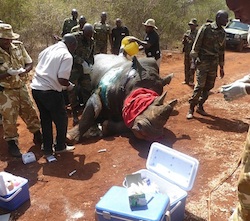Rhino treatment
RHINO TREATMENT
16 January 2018
By Victor Cheruiyot, Moses Nyayah and Moses Gitonga – Meru Field Team
Wild animals have special ways of survival. They behave in a manner that surprises us. Intriguingly, when animals are injured or sick, they tend to find ways to seek help – they get closer to the camps, in open areas and in most cases, sleep along the roads.
At Meru National Park, we have experienced such animal behavior after treating quite a number of them. Of all wild animals that have passed through our hands for treatment, most of them were sighted along the busy roads. Elephants, lions, zebras, giraffes, buffaloes, rhinos, etc when injured or sick have a tendency to get closer to human dwelling places or where people frequent.
Recently, as the Park’s rangers were doing their normal animal monitoring in the Rhino Sanctuary, they came across a male adult white rhino sleeping by the road side. On closer observation, they saw a festering would on the upper front leg.

Unfortunately the resident Meru Park Vet was away and therefore the rhino was monitored until the day after when a vet from another station would be mobilised. Interestingly, the sick rhino still kept his movements along the road.
When Dr. Dominic Mijele finally arrived, he darted the rhino from a KWS helicopter and treated him. According to Dr. Mijele, the rhino was suffering from a keratoris pilaris wound where an infection on the skin blocks the opening of the hair follicle causing rough, bumpy skin and eventually results in a wound.
The post-treatment monitoring of the rhino has been ongoing; he is on the road to recovery. Rhinos remain one of the most endangered species thus needs close attention and protection.
